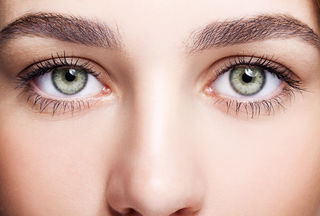Beauty
These Eyes
How the eyes affect your attractiveness and others' evaluations of you
Posted May 10, 2018
As I’m sure you’ve heard, the eyes are said to be “the windows to the soul.” This common saying speaks to the central role the eyes play in communication. They let us know a lot about how others feel and what they are experiencing. For example, they help to regulate communication by letting us know when others want to speak and by letting us know if people are paying attention to us. So it is not surprising that the eyes can play a major role in other’s judgements of our attractiveness.

The eyes are also windows to youth and health, two factors that play a key role in evaluating the attractiveness of individuals. Youth is equated with health, and because we desire healthy partners, attractiveness and health go hand in hand. There are, therefore, several age- and health-indicating characteristics of the eyes that are important to judging attractiveness.
Let’s start with one of the most familiar markers of eyes and attractiveness — size. Prior research shows that the size of the eyes affects how attractive we think others are. Men and women with large eyes are perceived as most attractive (see for example: Cunningham, 1986; Johnston, 2006; Wade, Irvine, & Cooper, 2004). This is because as we age, our eyes get smaller.
You might have guessed already that the whiteness of the eyes is important. Whiter sclera are equated with youth and health (Russell, Sweda, Porcheron, & Mauger, 2014), because as we age, our sclera darken, and some diseases involve darkening or changes in the whiteness of the sclera. Since we desire healthy partners, individuals with whiter sclera are rated as more appealing.
Here’s where it gets weird: How often have you thought about the limbal ring — the dark ring where the iris meets the sclera? Did you even know it had a name? Well, it’s important. Because the limbal ring fades as we age, men and women with a dark and distinct limbal ring are rated as more attractive than otherwise identical men and women with no limbal ring (Peshek, Semmaknejad, Hoffman, & Foley, 2011).
There are other factors beyond evaluating attractiveness in which the eyes are key to courtship. Consider some of the ways the eyes help evaluate a person’s interest in another individual. After all, how much does it really matter that one person finds another person attractive if that other person isn’t interested in them?
Demos, Kelley, Ryan, Davis and Whalen (2008) point out that we unconsciously notice others’ enlarged pupils. The emotion center of our brain registers this such that we rate men and women with larger pupils as more attractive (Hess, 1965; Toombs & Silverman, 2004). This occurs because pupil dilation indicates arousal as well as intelligence (Tsukahara, Harrison, & Engle, 2016). We find this attractive, because when someone is aroused in our presence, we interpret this as them being interested in us — and also because we want intelligent partners (Buss & Schmitt, 1993).
Finally, eye movements indicate how we feel about potential mates and friends. Research indicates that individuals gaze at the chest and head most when assessing potential mates and gaze at the legs and feet most when they assess potential friends (Gillath, Bahns, & Burghart, 2017). So the next time someone looks at your legs and feet a lot, you can expect that they just want to be friends. If they’re mostly looking higher, they might be interested in romance.
Keep your eyes open: They tell others a lot about you, and tell you a lot about others.
Facebook image: StockLite/Shutterstock
References
Cunningham, M. R. (1986). Measuring the physical in physical attractiveness: Quasi-experiments on the sociobiology of female facial beauty. Journal of Personality and Social Psychology, 50(5), 925.
Gillath, O., Bahns, A. J., & Burghart, H. A. (2017). Eye movements when looking at potential friends and romantic partners. Archives of Sexual Behavior, 46(8), 2313-2325.
Hess, E. H. (1965). Attitude and pupil size. Scientific American, 212(4), 46-55.
Johnston, V. S. (2006). Mate choice decisions: the role of facial beauty. Trends in Cognitive Sciences, 10(1), 9-13.
Peshek, D., Semmaknejad, N., Hoffman, D., & Foley, P. (2011). Preliminary evidence that the limbal ring influences facial attractiveness. Evolutionary Psychology, 9(2), 137-146.
Russell, R., Sweda, J. R., Porcheron, A., & Mauger, E. (2014). Sclera color changes with age and is a cue for perceiving age, health, and beauty. Psychology and Aging, 29(3), 626.
Tombs, S., & Silverman, I. (2004). Pupillometry: A sexual selection approach. Evolution and Human Behavior, 25(4), 221-228.
Tsukahara, J. S., Harrison, T. L., & Engle, R. W. (2016). The relationship between baseline pupil size and intelligence. Cognitive Psychology, 91, 109-123.
Wade, T. J., Irvine, K., & Cooper, M. (2004). Racial characteristics and individual differences in women's evaluations of men's facial attractiveness and personality. Personality and Individual Differences, 36(5), 1083-1092.
Zebrowitz, L. A. (1997). Reading faces: Windows to the soul? Boulder, CO: Westview Press.


